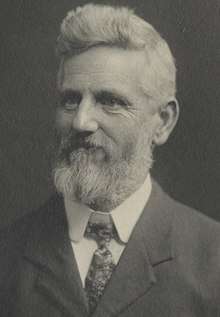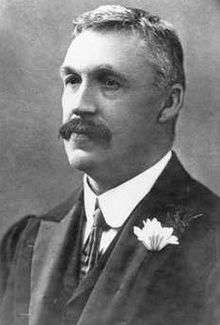1906 South Australian state election
State elections were held in South Australia on 3 November 1906, apart from the Northern Territory, which voted on 10 November.[1] This was a double dissolution election, and in the South Australian House of Assembly, all 42 seats were up for election. The incumbent United Labor Party (ULP) government led by Premier of South Australia Thomas Price with coalition partner the Liberal and Democratic Union (LDU) led by Archibald Peake, defeated the conservative opposition led by Leader of the Opposition Richard Butler. Each of the 13 districts elected multiple members, with voters casting multiple votes.
| |||||||||||||||||||||||||||||||||||||||||
All 42 seats in the South Australian House of Assembly 22 seats were needed for a majority | |||||||||||||||||||||||||||||||||||||||||
|---|---|---|---|---|---|---|---|---|---|---|---|---|---|---|---|---|---|---|---|---|---|---|---|---|---|---|---|---|---|---|---|---|---|---|---|---|---|---|---|---|---|
| |||||||||||||||||||||||||||||||||||||||||
| |||||||||||||||||||||||||||||||||||||||||
Background
The ULP became part of a unique "lab-lib" government, the Price-Peake administration minority government, following the 1905 election. The ministry was a coalition between the ULP led by Price, and the liberal group led by Peake. The deadlock over the franchise issue continued with the Legislative Council. After yet another attempt at reform, rejected by the Council, Price resigned his ministry, but when Butler, as leader of the opposition, was unable to form a ministry, Price/Peake remained in office. After more conflict with the Council, Price and Peake obtained an early election, and campaigned as a "ministerial alliance". At the same time, Peake agreed to pressure from within his group to form a new party – the Liberal and Democratic Union (LDU). This drew its membership from small wheat farmers, and at this stage, the LDU was firmly in favour of franchise reform, willing to be in coalition with the ULP, and opposed to both the conservative Australasian National League (ANL) and the Farmers and Producers Political Union (FPPU).
The ULP, on the fewest seats prior to the 1905 election, in just one election became the single largest party, increasing their primary vote to 41.3 (+22.2) percent and increasing their representation from five to 15 seats. After the new lower house first met, the ULP forced the incumbent conservative government to resign with the support of eight liberals. It was the start of the first stable Labor government in the world. In 1906, the ULP as the single largest party increased their primary vote to 44.8 (+3.5) percent with their seat representation increasing from 15 to 20 seats in the 42-member lower house, falling short by just two seats of a parliamentary majority. The ULP won all 12 city seats from the three city multi-member electorates, Adelaide, Port Adelaide and Torrens, with a policy of development and progress, expansion of business and honest government: "they would not be frightened by the nonsense that had been talked about socialism". The ULP continued to govern with the support of the LDU until Premier Price's death in 1909, after which Peake formed a minority government until the 1910 election when the ULP formed South Australia's first majority government.
Results
| Party | Votes | % | Swing | Seats | Change | |
| United Labor Party | 143,577 | 44.8 | +3.5 | 20 | +5 | |
| Australasian National League | 64,221 | 20.1 | +4.3 | 7 | –4 | |
| Liberal and Democratic Union | 31,671 | 10.0 | * | 9 | * | |
| Farmers and Producers | 28,180 | 8.8 | +0.0 | 5 | –4 | |
| Independent | 52,681 | 16.4 | –17.7 | 1 | –6 | |
| Total | 320,330 | 42 | ||||
| Labor/LDU coalition | WIN | |||||
| Australasian National League |
See also
- Members of the South Australian House of Assembly, 1906-1910
- Members of the South Australian Legislative Council, 1905–1908
- Members of the South Australian Legislative Council, 1908–1910
Notes
- "Statistical Record of the Legislature, 1836-2009" (PDF). Parliament of South Australia. Archived from the original (PDF) on 27 March 2015. Retrieved 2 February 2016.


.jpg)